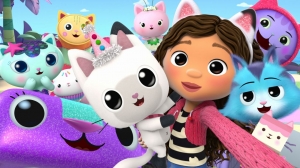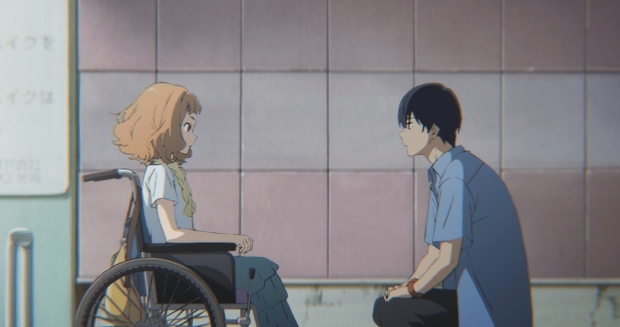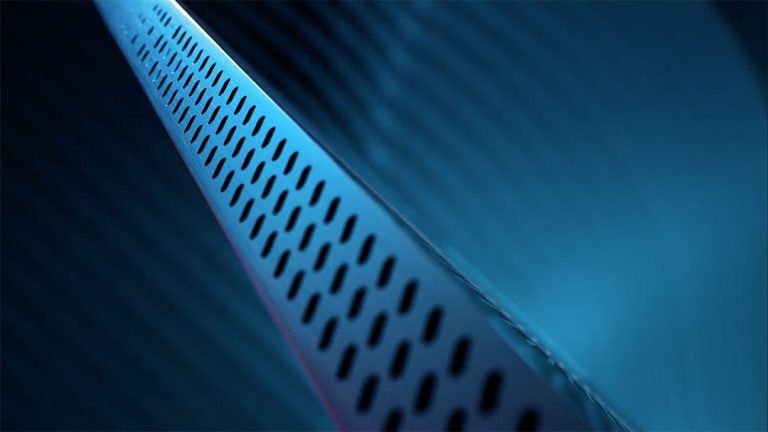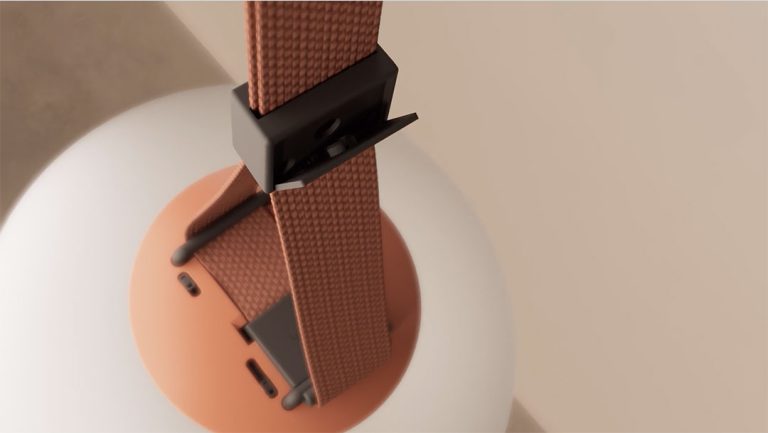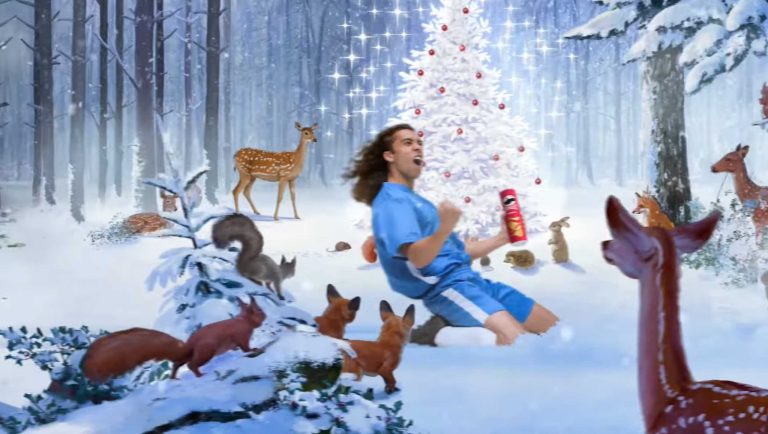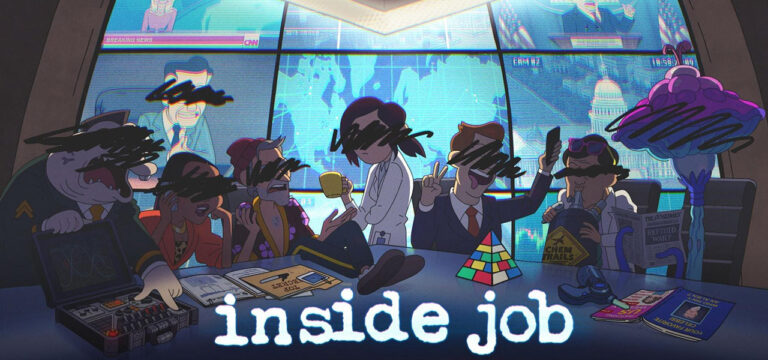With respect to why they chose to use 3D/CG over 2D, Twomey said that, while they had some early conversations about 2D, CG seemed like the best way to bring a real dollhouse to life – especially in light of DreamWorks’ great facility in that area. “The tangible textures, realistic shadowing and modeling, and toyetic aesthetic bring the rooms and characters alive in a way that 2D never could,” she went on. “Our viewers feel like they’ve actually shrunk in the dollhouse and are playing with Gabby and the Gabby Cats. What’s more exciting than the feeling of real rainbow sprinkles raining down on you from a true-to-life Cupcake Cat for a Sprinkle Party?! CG just makes the viewing experience that much more magical and real!”
“We know from our past experience creating shows how much kids respond to a real person looking into the camera and inviting them in to play,” Johnson explained. “We also know the power animation has to transport preschoolers into a uniquely fantastical world to tell imaginative stories. So, we decided to combine them both and have the live-action bookend the animation. This allows us to draw the viewer in at the top of the show, with the unboxing moment, and then let the animation take them along for the ultimate ride inside the magical world of the dollhouse.”
In addition to praising the creative problem-solving and troubleshooting skills of their colleagues, Johnson and Twomey were also quick to credit their team at DreamWorks for giving the show its signature look and feel. Art Director David Chung was brought on board early to help design the dollhouse and all the cats. With his special feel for soothing colors, textures, and “cuteness,” he helped build a cohesive and alluring world that draws kids in.
Of course, even the most colorful sprinkles and the cutest cats would be nothing (well, limited, anyway) without imaginative storylines. Fortunately, Johnson pointed out, the story possibilities in Gabby’s Dollhouse, a world filled with magic portals, enchanted rooms, and quirky characters, are virtually limitless.
As the show now streaming its second season on Netflix, we sat down with Jennifer Twomey and Traci Paige Johnson to find out a little more about how the magic is made, and how Gabby’s Dollhouse came to be the program of choice for the discriminating preschooler.
Gabby’s Dollhouse is back with more magical dollhouse deliveries to be unboxed! The popular live-action / animated preschool series began its second season on Netflix on August 10, with Gabby, Pandy Paws, and all their kitty friends embarking on new adventures, from creative crafts and cozy sleepovers to a cat-tastic party for a very special birthday kitty! Pretty much anything is possible inside the fantastical dollhouse full of adorable cat characters – a magical place where imperfection is celebrated and mistakes turn to growth through play, learning and discovery.
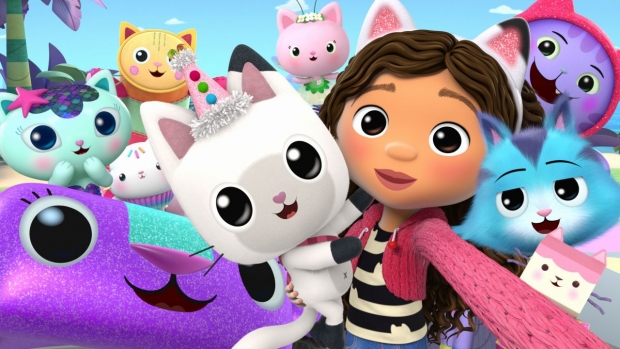
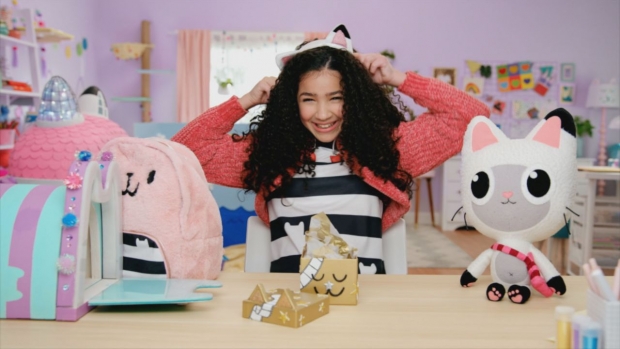
“Though it felt daunting and overwhelming at first, we’ve learned that there is always a simple way to achieve what’s in our heads,” Twomey added. “Maybe we use a 2D background for a new environment, reskin or color shift an existing model for a new character, or use a compositing effect instead of using animation. These limitations actually make us more creative.”
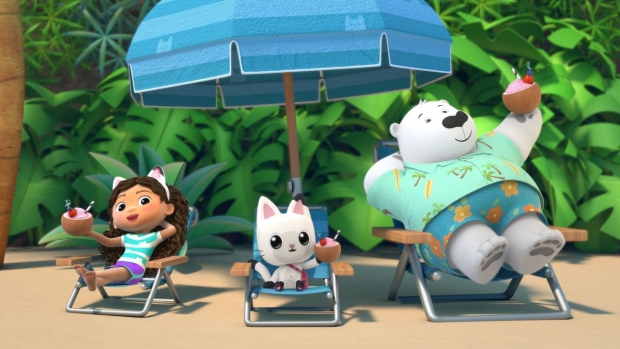
And the most enjoyable part of producing the series?
For his part, Supervising Producer Donovan Cook worked with the storyboarding teams to always board the angles to make viewers feel as if they have a seat at the table. “He also makes sure the characters are breaking the fourth wall and are looking to camera, as we want to include our audience and make them continuously feel that they’re on a play date with Gabby,” Johnson elaborated.
“The people!! Jen and I are so grateful to be working together, as we’ve been good friends for the past 25 years,” says Johnson. “We can finish each other’s sentences and we brainstorm so well together, laughing, and building creatively on each other’s ideas. We were also able to bring on old friends from past shows, like PT Walkley for music composition and Alden Ford for live-action directing, who know our aesthetic and take our ideas to a higher level.”
While not disputing the virtues of CG, Johnson pointed out that it also comes with its own special challenges, especially for first-timers. “We’ve always worked in 2D, where we were able to make changes to designs/backgrounds/characters during storyboards and animation if something wasn’t working well,” she shared. “CG is a whole other monster! What you gain in beauty of textures, colors, and modeling you lose in flexibility of making changes. Once you sign off on designs and backgrounds in CG, it’s a huge deal to make even the smallest of tweaks. You need to think out everything in detail beforehand. All of us on the production have gotten very good at flagging potential problems and brainstorming solutions before they even arise, but we do miss the ability to make changes along the way.”
And of course, they’ve also made new friends, including live-action host Laila Lockheart, who plays Gabby, and all the people at DreamWorks who help make Gabby’s Dollhouse a reality. “We’re a true family now,” says Twomey, “especially having bonded through COVID and having to figure out how to produce the show remotely, while still being able to laugh and handle problems gracefully. We epitomize taking teamwork to make the dream work!”
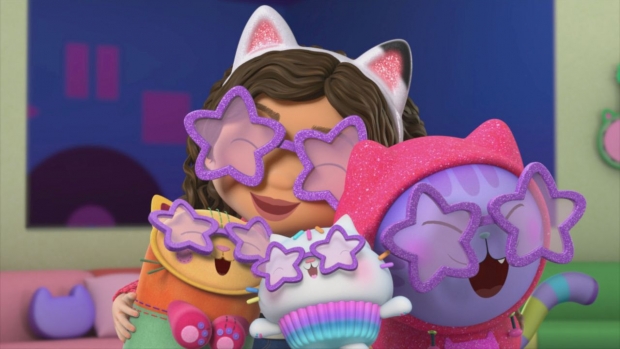
Created and executive produced by Traci Paige Johnson (Blue’s Clues, Daniel Tiger’s Neighborhood) and Jennifer Twomey (Blue’s Clues, Team Umizoomi), and featuring the voice talents of Laila Lockhart (Gabby), Tucker Chandler (Pandy Paws), and a host of talented cat impersonators, Gabby’s Dollhouse emphasizes personal growth, inspiring kids to turn their missteps and mistakes into something creative and beautiful. Through DIY crafting projects, baking recipes, and brain games, every room of Gabby’s Dollhouse is filled with fun activities, and every episode encourages flexible thinking and imaginative problem-solving through resilience and resourcefulness.
“Sometimes we’re inspired by what would be fun to unbox – a treasure map in a mini-bottle inspired our pirate episode, and tiny hamster kitties inspired a pets episode,” she recalled. “Of course, when it comes to executing these stories in CG, animatability is always a concern. We continuously meet with our teams about what existing assets we have to work with, and how to achieve animation that tells the story that’s within our budget.”
For starters, we asked what a hybrid live-action/animated format offered them that a fully animated format doesn’t.
Moreover, with established characters and more assets, environments, and models to work with in Season 2, the creators have been able to take the show to even greater imaginative heights. They’re getting to explore “all the nooks and crannies of the dollhouse” and are looking forward to all of the incredible stories they’ll be able to tell.

Jon Hofferman is a freelance writer and editor based in Los Angeles. He is also the creator of the Classical Composers Poster, an educational and decorative music timeline chart that makes a wonderful gift.
